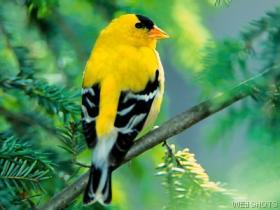
The American Goldfinch is a small finch, 11–13 centimeters (4–5 in) in length, with a wingspan of 19–22 centimeters (7–9 in). It weighs between 11–20 grams (0.39–0.71 oz).[8] The beak is small, conical, and pink for most of the year, though it turns bright orange with the spring molt in both sexes.[9] The shape and size of the beak are a result of adaptation, to aid in the extraction of seeds from the seed heads of thistles, sunflowers, and the other plants which make up its diet.
The American Goldfinch undergoes a molt in the spring and fall. The sexual dimorphism displayed in plumage coloration is especially pronounced after the spring molt, when the bright color of the male's summer plumage is needed to attract a mate.[10] It is the only cardueline finch to undergo a complete molt; other finches change plumage color by the gradual wearing-down of the feathers.[11] In each molt, it sheds all but the wing and tail feathers, which are dark olive in the female and black in the male. The markings on these feathers remain identical through each molt, with large white bars on the wings, and white feathers at the edges of the short, notched tail.
Once the spring molt is completed, the body of the male is a brilliant lemon yellow, a color produced by carotenoid pigments from plant materials in its diet,[12] with a striking jet black cap and white rump that is visible during flight.[13] The female is an olive yellow, with a yellow bib.[11] After the fall molt, the bright summer feathers are replaced with duller plumage. The goldfinch becomes buff below and olive-brown above, with a pale yellow face and bib. The fall plumage is almost identical in both sexes; the only markings which differentiate the sexes are the yellow shoulder patches of the male.[14] In some winter ranges, the goldfinches lose all traces of yellow, becoming a predominantly medium tan-gray color with an olive tinge evident only on close viewing.
The immature American Goldfinch is colored differently from the adult during its first fall and winter. The back is dull brown, and the underside is pale yellow. The shoulders and tail are dull black with buff-colored, rather than white, markings on wings and rump. This coloration is the same in both genders.
The song of the American Goldfinch is a series of musical warbles and twitters, often with a long note. A tsee-tsi-tsi-tsit call is often given in flight; it may also be described as per-chic-o-ree.[9] While the female incubates the eggs, she calls her returning mate with a soft continuous teeteeteeteete sound. The young begin to use a call of chick-kee or chick-wee shortly before fledging, which they use until they have left the nest entirely.[10] There are two defense calls made by adults during nesting; a sweeet call made to rally other goldfinches to the nest and distract predators, and a bearbee used to signal to the nestlings to quiet them and get them to crouch down in the nest (to become less conspicuous).


No comments:
Post a Comment